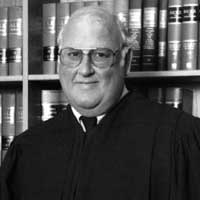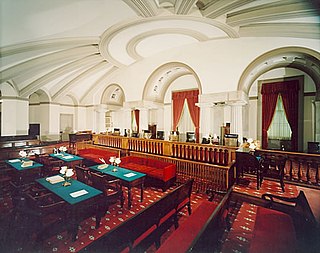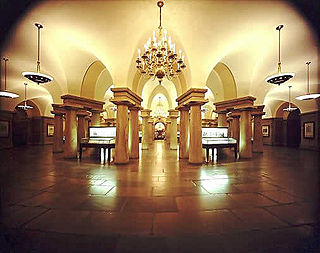
Thoroughgood "Thurgood" Marshall was an American civil rights lawyer and jurist who served as an associate justice of the Supreme Court of the United States from 1967 until 1991. He was the Supreme Court's first African-American justice. Prior to his judicial service, he was an attorney who fought for civil rights, leading the NAACP Legal Defense and Educational Fund. Marshall was a prominent figure in the movement to end racial segregation in American public schools. He won 29 of the 32 civil rights cases he argued before the Supreme Court, culminating in the Court's landmark 1954 decision in Brown v. Board of Education, which rejected the separate but equal doctrine and held segregation in public education to be unconstitutional. President Lyndon B. Johnson appointed Marshall to the Supreme Court in 1967. A staunch liberal, he frequently dissented as the Court became increasingly conservative.

The Old Brick Capitol in Washington, D.C., served as the temporary meeting place of the Congress of the United States from 1815 to 1819, while the Capitol Building was rebuilt after the burning of Washington.

The Architect of the Capitol (AOC) is the federal agency responsible for the maintenance, operation, development, and preservation of the United States Capitol Complex. It is an agency of the legislative branch of the federal government and is accountable to the United States Congress and the Supreme Court. Both the agency and the head of the agency are called "Architect of the Capitol". The head of the agency is appointed to a 10-year term by the president of the United States, confirmed by the United States Senate, and is accountable to the president.

Southwest is the southwestern quadrant of Washington, D.C., the capital of the United States, and is located south of the National Mall and west of South Capitol Street. It is the smallest quadrant of the city, and contains a small number of named neighborhoods and districts, including Bellevue, Southwest Federal Center, the Southwest Waterfront, Buzzard Point, and the military installation known as Joint Base Anacostia–Bolling.

Judiciary Square is a neighborhood in the northwest quadrant of Washington, D.C., the vast majority of which is occupied by various federal and municipal courthouses and office buildings. Judiciary Square is located roughly between Pennsylvania Avenue to the south, H Street to the north, 6th Street to the west, and 3rd Street to the east. The center of the neighborhood is an actual plaza named Judiciary Square. The Square itself is bounded by 4th Street to the east, 5th Street to the west, D Street and Indiana Avenue to the south, and F Street to the north. The neighborhood is served by the Judiciary Square station on the Red Line of the Washington Metro, in addition to Washington Metropolitan Area Transit Authority bus stops.

The Supreme Court Building houses the Supreme Court of the United States, the highest court in the federal judiciary of the United States. The building serves as the official workplace of the chief justice of the United States and the eight associate justices of the Supreme Court. It is located at 1 First Street in Northeast Washington, D.C. It is one block immediately east of the United States Capitol and north of the Library of Congress. The building is managed by the Architect of the Capitol. On May 4, 1987, the Supreme Court Building was designated a National Historic Landmark.

Jack Richard Miller was an American politician and jurist who served as a Republican United States Senator from Iowa for two terms from 1961 to 1973. He later served as a United States circuit judge of the United States Court of Appeals for the Federal Circuit.

The United States Capitol Complex is a group of twenty buildings, grounds, and facilities in Washington, D.C., that are used by the United States Congress, and Federal courts. The buildings and grounds within the complex are managed and supervised by the architect of the Capitol.

Ralph Karl Winter Jr. was a United States circuit judge of the United States Court of Appeals for the Second Circuit.

The Postal Square Building served as the main post office for the city of Washington, D.C., from the building's completion in 1914 to 1986. It now houses the National Postal Museum, the Bureau of Labor Statistics, and offices of the United States Senate. Architect Daniel Burnham designed the building in the Beaux-Arts style—the same style Burnham used for the neighboring Union Station. Construction for the Postal Square Building began in 1911 on a lot near the Capitol. Planning began with a 1901 proposal by the Senate Parks Commission. The commission called for three buildings to mark the northern end of the Capitol complex. While the first two buildings in the plan, Union Station and the Postal Square Building, were completed early in the 20th century, the 1901 plan would not be fully implemented until the completion of the Thurgood Marshall Federal Judiciary Building in 1992.

Thurgood Marshall Jr. is an American lawyer and son of the late United States Supreme Court Justice Thurgood Marshall. Marshall worked in the Bill Clinton White House and is a retired international law firm partner. He also served as chairman of the Board of Governors of the United States Postal Service and as a member of the Board of Trustees of the Ford Foundation.

Edward Larrabee Barnes was an American architect. His work was characterized by the "fusing [of] Modernism with vernacular architecture and understated design." Barnes was best known for his adherence to strict geometry, simple monolithic shapes and attention to material detail. Among his best-known projects are the Haystack School, Christian Theological Seminary, Dallas Museum of Art, the Walker Art Center, 599 Lexington Avenue, the Thurgood Marshall Federal Judiciary Building, and the IBM Building at 590 Madison Avenue.

The Old Supreme Court Chamber is the room on the ground floor of the North Wing of the United States Capitol. From 1800 to 1806, the room was the lower half of the first United States Senate chamber, and from 1810 to 1860, the courtroom for the Supreme Court of the United States.

The United States Capitol crypt is the large circular room filled with forty neoclassical Doric columns directly beneath the United States Capitol rotunda. It was built originally to support the rotunda as well as offer an entrance to Washington's Tomb. It currently serves as a museum and a repository for thirteen statues of the National Statuary Hall Collection.
Washington, D.C., is the capital city and federal district of the United States. Below is a list of Washington, D.C.-related articles.

John Marshall was an American statesman, lawyer, and Founding Father who served as the fourth chief justice of the United States from 1801 until his death in 1835. He remains the longest-serving chief justice and fourth-longest serving justice in the history of the U.S. Supreme Court, and is widely regarded as one of the most influential justices ever to serve. Prior to joining the court, Marshall briefly served as both the U.S. secretary of state under President John Adams, and a representative, in the U.S. House of Representatives from Virginia, thereby making him one of the few Americans to serve on all three branches of the United States federal government.

On May 10, 2010, President Barack Obama announced his selection of Elena Kagan for Associate Justice of the Supreme Court of the United States, to replace retiring Justice John Paul Stevens. Kagan's nomination was confirmed by a 63–37 vote of the United States Senate on August 5, 2010. When nominated, Kagan was Solicitor General of the United States, a position to which Obama had appointed her in March 2009. Kagan was the first Supreme Court nominee since Sandra Day O'Connor in 1981 to not be a sitting circuit court judge and the most recent such nominee as of 2023. She was the first Supreme Court nominee since William Rehnquist and Lewis F. Powell Jr. in 1971 to not be a sitting judge on any court.

Chief Justice John Marshall is a bronze sculpture of John Marshall, by American sculptor William Wetmore Story. It is located at the Supreme Court, 1 First Street, Washington, D.C., N.E.

Thurgood Marshall was nominated to serve as an associate justice of the Supreme Court of the United States by U.S. President Lyndon B. Johnson on June 13, 1967 to fill the seat being vacated by Tom C. Clark. Per the Constitution of the United States, the nomination was subject to the advice and consent of the United States Senate, which holds the determinant power to confirm or reject nominations to the U.S. Supreme Court. Marshall was confirmed by the U.S. Senate in a 69–11 vote on August 30, 1967, becoming the first African American member of the Court, and the court's first non-white justice.





















